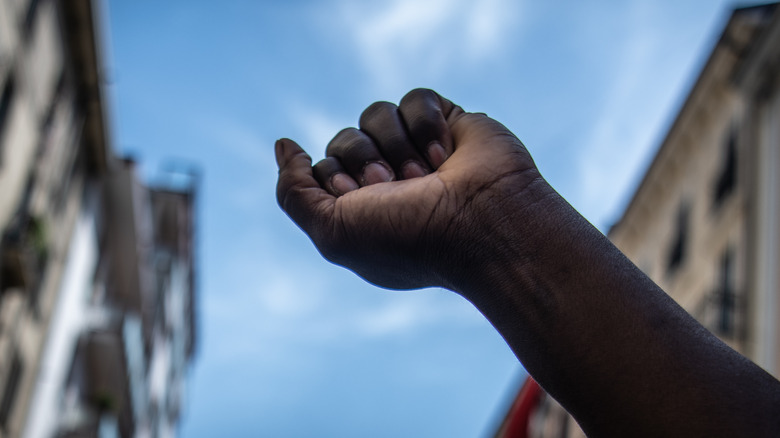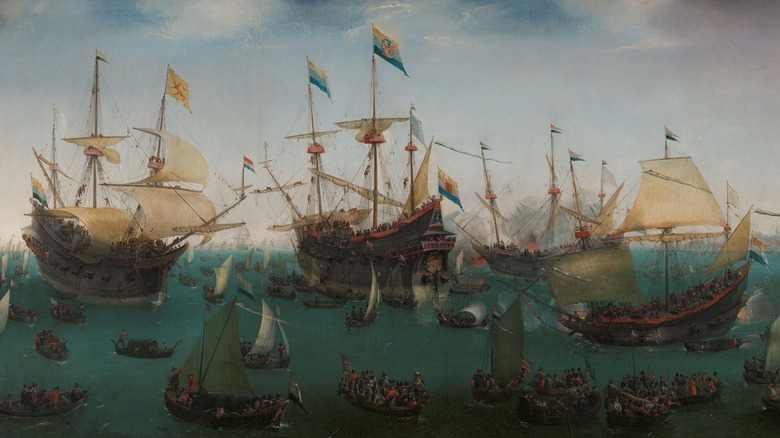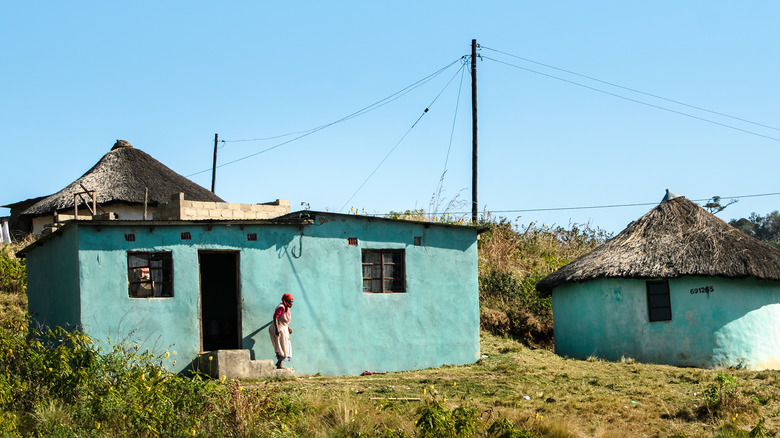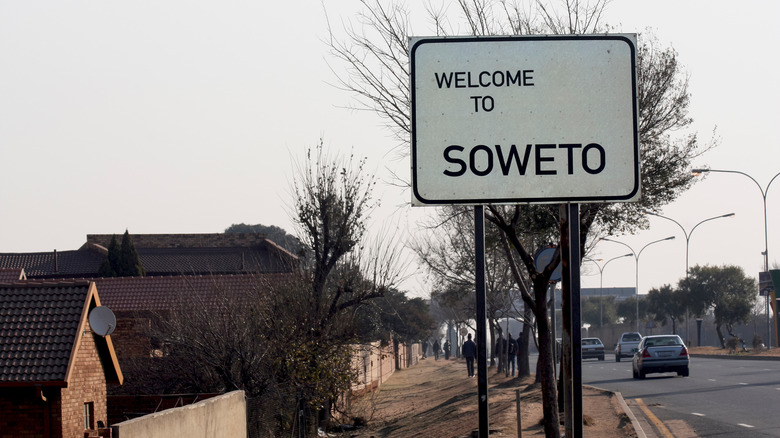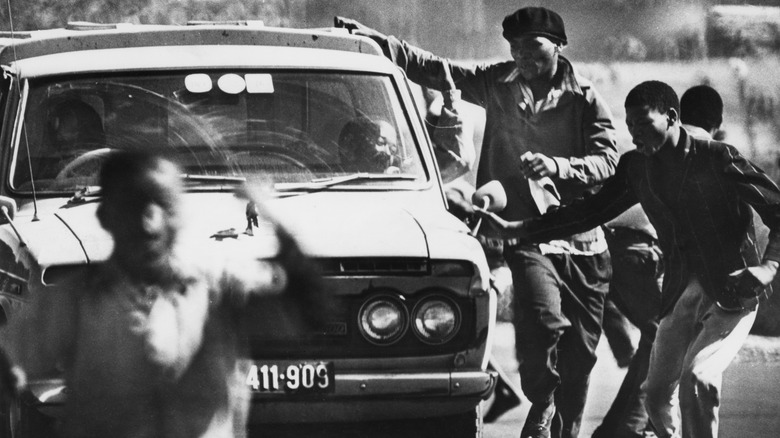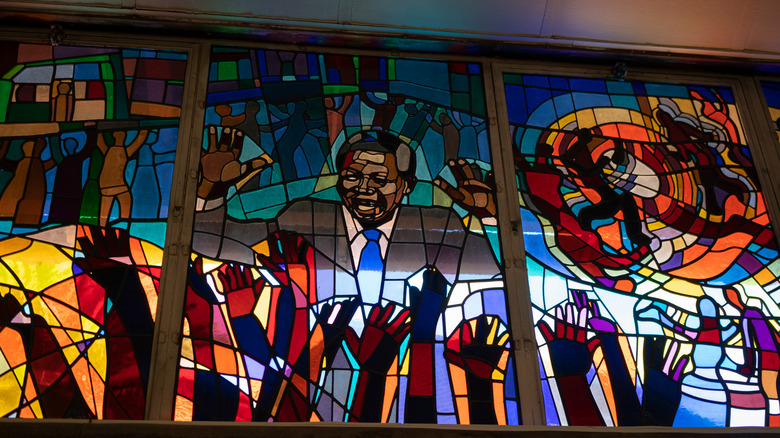Why The Death Total From The Soweto Uprising Is Clouded In Doubt
The past few hundred years or so of human history has been marked by massive overall improvements in healthcare, standards of living, access to food and water, personal freedoms, and more, as hard data on sites like Vox illustrate. At the same time, the transition from medieval to modern hasn't exactly been easy or bloodshed-free. And now, in the present, folks in countries across the globe grapple everyday with the fallout — the ramifications of empire.
Every single colonial occupation — the so-called "New World" starting in the very late-15th century (via World History Encyclopedia), India in the mid-18th century (via India Today), Australia in the late-18th century (via Australians Together), and countless more — has irrevocably altered the everyday lives, cultures, and languages of indigenous peoples. But even ancient Rome, a very militaristic, pragmatically governed republic-turned-empire, never took the one, final, rather insidious step to total domination: forcible language change. As World History Encyclopedia reminds us, Rome was extremely multicultural, multiethnic, and multi-language. No one was forced to speak Latin.
In the much more recent past, however, the modern-day nation of South Africa survived a very different and tragic history. At present, 11 languages are spoken in South Africa — all of them are official (via South Africa Gateway). The path to such tolerance required enduring hundreds of years of Dutch colonization, the repression of apartheid, and a key, nation-changing event centered around the use of the Afrikaans language: the Soweto Uprising.
Before and after colonization
The southernmost tip of the African continent has always been a crossroads for human travel and various tribal groups, as South African History online describes, even for pre-Homo sapiens human species. By about 2,000 years ago, as the South African Government's website says, the Khoekhoen lived along the coast, the San (aka "Bushmen") lived across the entire region, and speakers of the Bantu language — from which many modern South African languages derive (via South Africa Gateway) — started migrating into the area. In short, the stage was long set for South Africa to be a very rich, dense place of intermingled languages and traditions.
As the South African journal Scientific Electronic Library Online (SciELO) describes, the English and Dutch first made landfall in South Africa in the 1590s. They traded cattle and sheep with locals for copper, iron, and tobacco on the journey east, which necessitated circling around the entire African continent. By 1652, as Facing History explains, these traders settled in the Cape of Good Hope, and by 1685 expanded outwards as arriving settlers fled religious persecution in Europe.
Following an extended conflict over control of the cape, the English wound up taking over in 1806. By 1834, they had abolished slavery. Many Dutch migrants, poor frontier farmers called "Boers," pressed inland and got embroiled in already-existing conflicts between the Zulu, Xhosa, and Sotho tribes. They all fought each other, all grew to despise the English, and from this turmoil came Afrikaans and apartheid alike.
The apartness of Apartheid
In 1910, South Africans — both Black and white — managed to form their own British colony, the Union of South Africa. As Facing History explains, this assembled the territories of Cape Colony, Natal, the Orange Free State, and Transvaal into one collective. Dutch settlers and African natives alike congregated under the self-describing banner "Afrikaners," in an attempt to establish their own singular identity and distinguish themselves from the English. A big part of this identity was Afrikaans, originally a local dialect based on Dutch and mixed with English, German, Portuguese, Malay, Khoikhoi, and more. It was spoken by all South African races and classes.
Despite this, and despite the official dissolution of slavery within the British empire, the Union of South Africa — predominated by British capitalists — developed a race-based system of work that not only separated Black and white Afrikaners from each other, but actively oppressed Black Afrikaners by restricting them into oppressive, low-wage work. The 1913 Land Act made things worse, as History tells us, by making it illegal to employ Black Africans as sharecroppers. This might sound beneficent, but it only marked the beginnings of complete geographical segregation between Black and white people.
From then to 1948, a vocal, white extremist faction of the South African government came into power. In a nutshell, it advocated the complete separation of Black and white people, whether Afrikaners or not. Thus began the era known as "apartheid," a Dutch word literally meaning "apartness."
Massacre at Soweto
Apartheid was a brutal system of segregation that only grew more savage over time. It crossed into every area of life, including — crucially, as it relates to the Soweto Uprising — health care (via the Borgen Project). As History tells us, marriage and sexual relations between Black and white people were prohibited come 1950. That same year the Population Registration Act categorized people into three categories, later expanded to four: "white," "Bantu" (Black), "Colored" (mixed race) and "Asian" (Indian and Pakistani). In 1958, the "Bantu" were pushed further into 10 reservation-like "Bantustans." Later on, from 1961 to 1994, the government repossessed land from a full 3.5 million Black Africans and sold it to white farmers.
Bantu, remember, is one of the progenitor languages of numerous South African tribes, as South Africa Gateway explains, and includes isiXhosa, isiZulu, siSwati, and more. People still spoke these languages during apartheid, as well as Afrikaans. Afrikaans, though — the communal language — came to be seen as "the language of the oppressor," as South African Broadcasting Corporation (SABC) News puts it.
The tipping point came in 1974, when the South African government tried to make Afrikaans the mandatory language of education, as Deutsche Welle describes. Afrikaans was on the decline, and authorities wanted to make sure it remained central. By June 16, 1976, students congregated at the township of Soweto in Johannesburg to protest. The protesters were forced to change their marching route because the police barred the way, and the police opened fire.
Beyond the numbers of death
The events at Soweto became immortalized through a single picture. That picture, seen in The Guardian, shows 13-year-old Hector Pieterson laying dead in the arms of a fellow student, with his sister Antoinette Sithole next to him. He was one of the first to die. "We ran to the clinic," Sithole said, "but we could see he was finished. There and then I understood he was dead."
The protest, which was essentially a peaceful march, had been organized ahead of time by the Action Committee of the Soweto Students Representative Council (SSRC), and involved a number of nearby schools and administrators, as Africa News explains. It was supposed to start at two high schools and end at Orlando Stadium. Some students intended to march from the get-go, while others joined later. It's difficult to say precisely how many people went, but estimates range from 10,000 to 20,000 (via The Guardian and Deutsche Welle).
In the end, somewhere between 100 to 700 people died. Why the imprecise numbers? It shouldn't be too difficult to understand. Who would the families of victims have reported to? Would those authorities have announced the death toll to the international community, or even kept an exact record? Who, in the chaotic milieu of gunfire and tear gas, and bodies carried to black-only clinics and healthcare facilities, would have stopped to count the dead? It stands to reason that some victims would have been left where they fell, or maybe just carried back home.
All languages and voices heard
The Soweto Uprising, and its deaths, were critical to the eventual abolition of apartheid. It took a while, but come 1991 South African president Frederik Willem de Klerk, in conjunction with legendary activist Nelson Mandela, began to repeal many of the laws related to apartheid, as History describes. For this they were awarded the Nobel Peace Prize in 1993. At the same time, the African National Congress (ANC) grew in strength. Formed in 1912 as a nationalist, Black political party, it was banned from participating in government from 1960 to 1990, as Britannica says. In 1994, Nelson Mandela, the head of the ANC, was voted South Africa's first Black president. He served until 1999.
As Voice of America News describes, South Africans tend to regard the Soweto Uprising "with sadness, but no regrets." Florence Kganye, who was 18 years old in 1976 and participated in a different set of protests in Bloemfontein, said, "It was worth it. Because what we fought for, what the other students that died fought for, at least we do have the freedom now that we were fighting for." Hector Pieterson, the aforementioned boy in the Soweto Uprising's iconic photo, has had a museum and memorial founded in his honor, as seen on South African History Online.
And yet, many South Africans still feel that their nation "has a long way to go." Older people remember growing up during apartheid. But at least they can tell their stories in whatever language they please.
